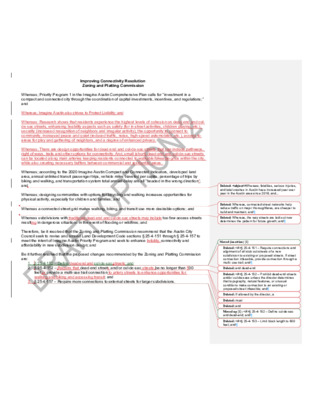12 Submitted by Thompson - Improving Connectivity Alt Recommendation.pdf — original pdf
Backup

Improving Connectivity Resolution Zoning and Platting Commission Whereas; Priority Program 1 in the Imagine Austin Comprehensive Plan calls for “investment in a compact and connected city through the coordination of capital investments, incentives, and regulations;” and Whereas; Imagine Austin also strives to Protect Livibility; and Whereas: Research shows that residents experience the highest levels of cohesion on dead-end and cul- de-sac streets, enhancing livability aspects such as safety (for in-street activities, children playing, etc.), security (increased recognition of neighbors and irregular activity), the opportunity to connect to community, increased peace and quiet (reduced traffic, noise, high-speed automobiles, etc.), access to areas for play and gathering of neighbors, and a degree of enhanced privacy. Whereas; There are design opportunities for dead-end and cul-de-sac streets that can include pathways, right of ways, trails and other options for connectivity. And, small (short) dead-end and cul-de-sac streets can be located along main arteries keeping residents connected to walkable/bikeable grids within the city, while also creating necessary buffers between commercial and residential areas. Whereas; according to the 2020 Imagine Austin Compact and Connected Indicators, developed land area, annual unlinked transit passenger trips, vehicle miles traveled per capita, percentage of trips by biking and walking, and transportation system total annual delay are all “headed in the wrong direction”; and Whereas; designing communities with options for bicycling and walking increases opportunities for physical activity, especially for children and families; and Whereas a connected street grid makes walking, biking, and transit use more desirable options; and Whereas subdivisions with traditional dead-end and cul-de-sac streets may include too few access streets resulting in dangerous situations in the event of flooding or wildfires; and Therefore, be it resolved that the Zoning and Platting Commission recommend that the Austin City Council seek to revise and amend Land Development Code sections § 25-4-151 through § 25-4-157 to meet the intent of Imagine Austin Priority Program and seek to enhance livibility, connectivity and affordability in new subdivision design; and Be it further resolved that the proposed changes recommended by the Zoning and Platting Commission are: 1. § 25-4-152 – Define dead-end and cul-de-sac streets; and 2. § 25-4-152 – Require that dead-end streets and/or cul-de-sac streets be no longer than 500 feet or provide a multi-use trail connection to artery streets to enhance opportunities for walking and biking and accessing transit; and 3. § 25-4-157 – Require more connections to external streets for larger subdivisions. Deleted: <object>Whereas; fatalities, serious injuries, and total crashes in Austin have increased year over year in the Austin area since 2018; and… Deleted: Whereas, connected street networks help reduce traffic on major thoroughfares, are cheaper to build and maintain; and¶ Deleted: Whereas, the way streets are laid out now determines the pattern for future growth; and¶ Moved (insertion) [1] Deleted: <#>§ 25-4-151 – Require connections and alignment of all stub out streets of a new subdivision to existing or proposed streets. If street connection infeasible, provide connection through a multi- use trail; and¶ Deleted: and dead-end Deleted: <#>§ 25-4-152 – Prohibit dead-end streets and/or cul-de-sacs unless the director determines that topography, natural features, or unusual conditions make connection to an existing or proposed street infeasible; and¶ Deleted: If allowed by the director, a Deleted: must Deleted: and Moved up [1]: <#>§ 25-4-152 – Define cul-de-sac and dead-end; and¶ Deleted: <#>§ 25-4-153 – Limit block length to 600 feet; and¶